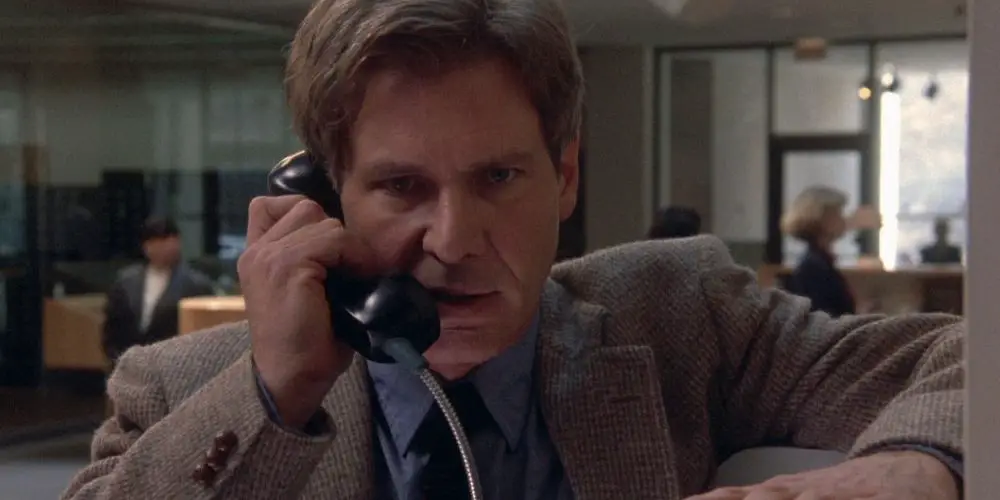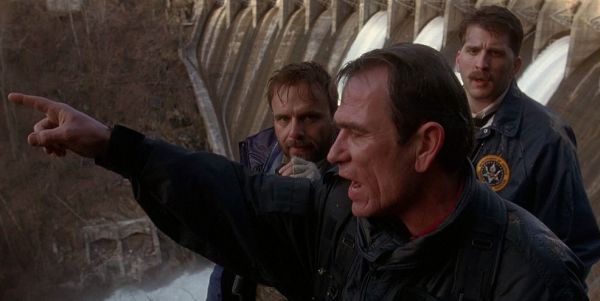Film Analysis Of THE FUGITIVE: Layers Of Meaning

All articles contributed by people outside of our team are…
In Andrew Davis’ brilliant 1993 thriller The Fugitive, the filmmakers use a variety of techniques to lead the viewer through the story. They drop hints with color and lighting that viewers are not necessarily trained to consciously notice while they’re watching, and employ a gripping editing style that effectively supports the cat-and-mouse game that embroils the film’s two main characters.
Every movie has content, which is what is seen and heard on screen, and what is referred to as form, which is the way in which the film’s creators manipulate that content to their own ends and present it to the viewer. The filming and production techniques used by the filmmakers of The Fugitive intelligently support the content of the movie, and raise it to a level that exceeds the expectations of the audience for cinematic fare of its type.
Setting the tone
In the opening scene of The Fugitive, the viewer is presented with a split introduction, comprised of an overhead view of a city, and that of a woman being murdered. In the latter, which is filmed in black-and-white, it is not known who the woman is, and due to the way the scene is shot, her attacker cannot be fully seen.

The cinematic language used here, which are the methods utilized by filmmakers to communicate with the audience, indicates that the creators want the viewers to know that a woman is being brutalized, and that the film is set in a city. Being that the crux of the story is a murder mystery, it is important that all that is seen of the attacker that early on is a shadowy figure, and the filmmakers reinforce the movie’s theme by keeping the identity of the murderer unknown.
In this scene, the movie manipulates both space and time, in that it shows the audience what is happening in two different places, and in that while the camera is panning over the city, the sound of sirens is audible, which is presumed to be that of the first responders heading to the scene of the crime. With that, it is clear that the cityscape shot is happening after the murder.
Parallel editing
Another technique used by the film’s creators is parallel editing, which shows the viewer what is going on with two different characters, in two different places, at different times. This technique is demonstrated during the scene in which Deputy U.S. Marshall Gerard (Tommy Lee Jones) is rounding up and instructing local police forces to find Dr. Richard Kimble (Harrison Ford), who is on the run after being convicted of murdering his wife and escaping a crashed prison bus.
The scene cuts back and forth from Gerard to Kimble, as the former ponders the next step in the investigation, and the latter continues to flee. Patterns develop as the movie progresses, such as in the way Kimble continues to show up in public places despite the highly-publicized manhunt for him, and remains just a step ahead of Gerard, or manages to narrowly avoid capture.
These patterns are evidenced with scenes such as the meeting of the two in the dam tunnel, Kimble’s appearance at the jail to speak to another inmate who may have helpful information for him, and multiple instances in which he strolls into hospitals.
Implicit meaning: miscarriage of justice
Every movie has an explicit meaning and an implicit one, and a given film may have several, depending on the filmmaker’s intentions and the experience of the audience. Explicitly, The Fugitive is about a successful doctor who is wrongfully accused and convicted of killing his wife, escapes a prison transport, and sets out to find the actual culprit, with a sharp and determined U.S. Marshall hot on his heels all the while.
[easy-tweet tweet=”The Fugitive shows practiced apathy in law enforcement; innocence is just an afterthought.” user=”FilmInquiry” usehashtags=”no” template=”light”]Beneath that high-level description of the movie lies a social commentary about the overzealous judicial system that all too often miscarries justice in the United States. The movie features investigators who clearly did not look beyond planted and circumstantial evidence of Kimble’s supposed guilt, and employs the police procedural trademark of the smug prosecuting attorney who arrogantly preys upon the emotions of the jury, regardless of how sound the evidence against the defendant actually is.

Beyond that, the striking scene in which Gerard and Kimble meet for the first time shows that Gerard only cares about catching his target. As Kimble holds Gerard at gunpoint, he screams “I didn’t kill my wife!” to which Gerard replies, “I don’t care!” This demonstrates a practiced apathy on the part of law enforcement at large, as guilt or innocence is just an afterthought, and the primary objective is to merely get the collar and make an example out of the convicted.
The film also delves into the corruption often displayed by powerful pharmaceutical companies, providing another implicit meaning. It is revealed in the movie that Kimble blew the whistle on an ineffective and dangerous prescription drug, and the company responsible for creating it attempted to silence him and got to his wife instead.
Pushing genre boundaries
As far as genre is concerned, The Fugitive is typically considered a thriller, but can also be pegged as a bonafide action movie. The movie has all the makings of a thriller, as it depicts a wrongfully accused hero, a murder mystery, a cat-and-mouse game between the protagonist and an authority figure, and a winding plot that has the hero piece together clues to prove his innocence, all while barely evading capture.
Also, the film is loaded with explosions, gun fights, helicopter chases, and other conventions that scream of the action genre. Thriller and action categorizations in film often go hand-in-hand, and a particular film can certainly fall under both. Whether thought of as a thriller, action movie, or both, The Fugitive was innovative in several ways.
While movies in both genres use music to add to the viewing experience, the score in this film is almost constantly present, and the mood of the music drives the action, warning the viewer of imminent surprise or danger. The filmmakers also used the tactic of inversion during the opening scene of the movie, essentially presenting a shot of the death of Kimble’s wife in negative exposure, reversing the natural colors of the shot.

This accomplishes the placement of a subconscious notion in the viewer’s mind that the life is beginning to leave her body as the ghostly image is seen. While black-and-white filming is a fairly common method used by filmmakers in any genre, the use of inversion is much rarer, and is meant to send an important message to the audience.
Conclusion
The Fugitive is a well-written, superbly-acted action-thriller that proves just how great those genres can be. Strong performances from the main actors and supporting cast abound, the ominpresent score subconsciously keeps the viewer on the edge of their seat, and the film acts as a social commentary in its underlying indictment of the supposedly infallible United States justice system, as well as of the unbridled greed and power that are characteristic of large pharmaceutical companies.
The filmmakers use parallel editing to show the viewer what both of the main characters are doing as they scramble to achieve their missions, and because those characters are matched in their intelligence, their meetings and near misses make for a taut film that defines the genres in which it can be placed.
The Fugitive is not devoid of common conventions found in the action or thriller genres, but smart writing, outstanding performances, and the underlying meanings of the film keep it far from being a standard popcorn flick.
What do you appreciate most about The Fugitive? Share your thoughts in the comments below.
Guest Author
Ryan Taggart
My name is Ryan Taggart and more than most things in life, I love watching movies and writing about them. I run a blog called The No Seatbelt Blog where I write about movies, music, toys and action figures, beer, and more.
Find Ryan at @taggsonian and @noseatbeltblog on Twitter, and Facebook.
Does content like this matter to you?
Become a Member and support film journalism. Unlock access to all of Film Inquiry`s great articles. Join a community of like-minded readers who are passionate about cinema - get access to our private members Network, give back to independent filmmakers, and more.
All articles contributed by people outside of our team are published through our editorial staff account.













